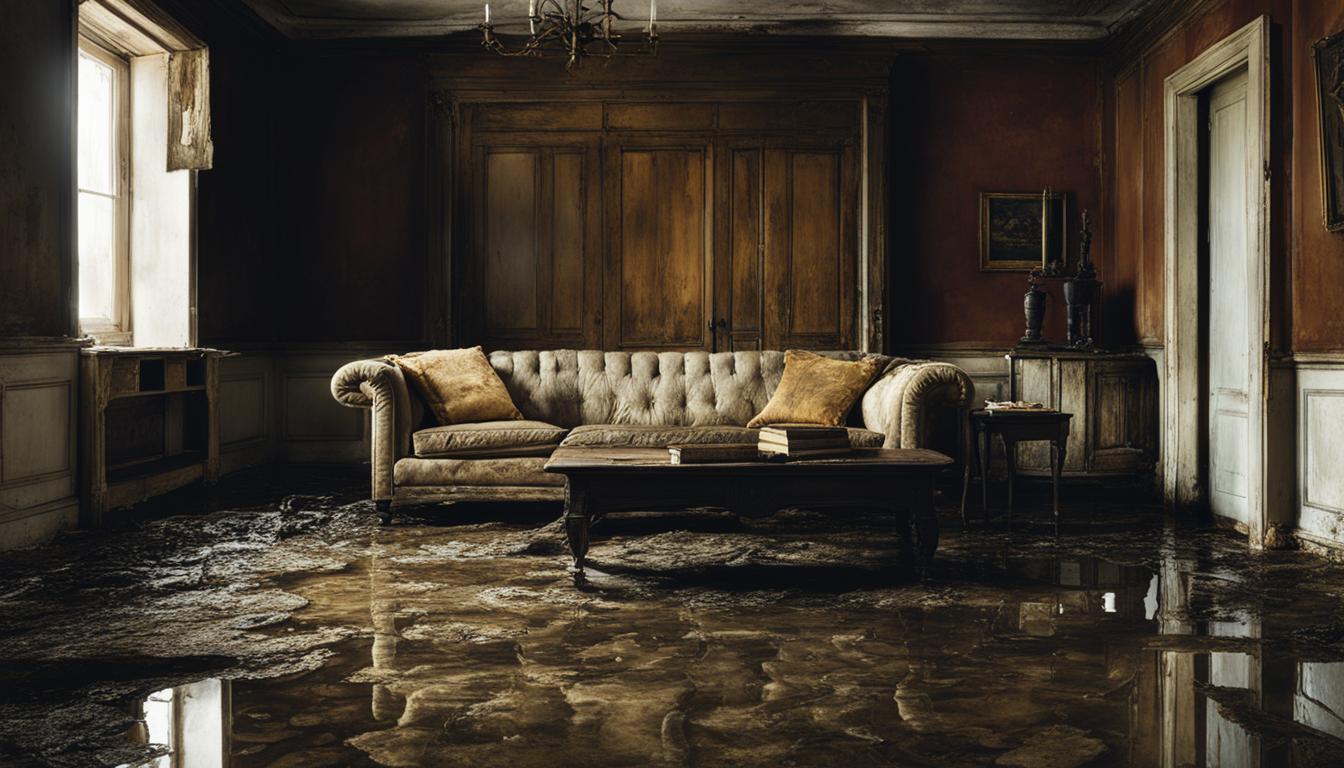Whether it’s due to a burst pipe or a leaky roof, water damage in your home can be a major headache. While some damage can be fixed quickly, permanent water damage can have lasting effects on your home’s structure and value. How do you know if water damage is permanent? Look for these key signs:
Key Takeaways
- Permanent water damage can have serious long-term effects on your home.
- Visible mold growth, musty odors, and stained or discolored surfaces are all signs of water damage.
- Warped or buckled flooring, structural issues, and persistent plumbing problems can also indicate permanent water damage.
- If you notice these signs, it’s crucial to take action promptly to prevent further damage.
- Regular maintenance and inspections can help you catch water damage before it becomes permanent.
Visible Mold Growth
One of the most common signs of water damage is visible mold growth. Mold thrives in damp environments, making it a clear indication that moisture has been present in your home for some time. If left unaddressed, this prolonged exposure to moisture can result in structural damage and other long-term issues, making the water damage potentially permanent.
To determine whether mold is present, inspect surfaces such as walls, ceilings, and floors for any patches of discoloration or fuzzy growth. In many cases, the color of the mold can be an important clue in identifying its type. For example, black mold is particularly dangerous, as it can cause serious respiratory problems, particularly in individuals with weakened immune systems. If you suspect that there is mold in your home, it is important to act quickly to prevent it from spreading.
| Key Takeaways: |
|---|
| Visible mold growth is a telltale sign of water damage caused by prolonged exposure to moisture in your home. |
| Mold can cause structural damage and other long-term issues if not addressed promptly, resulting in potentially permanent water damage. |
| If you suspect mold growth in your home, inspect surfaces for patches of discoloration or fuzzy growth and take quick action to prevent it from spreading. |
Musty Odor
A musty or damp smell in your home is another strong indication of water damage. This odor is often caused by the presence of mold or mildew, which thrive in damp environments. If the odor persists, even after thorough cleaning, it could be a sign of hidden water damage that has penetrated materials such as carpets, drywall, or insulation. This type of damage may require professional intervention to prevent further deterioration.
It’s essential to address musty odors as soon as possible, especially if they are persistent. The longer you wait, the greater the chances of permanent water damage. This can result in costly repairs and even health risks from mold exposure.
Stained or Discolored Surfaces
If you notice stains or discoloration on your walls, ceilings, or floors, it could be a sign of water damage. When water seeps into porous materials, it often leaves behind visible traces of its presence. Some stains may be easy to remove superficially, but persistent discoloration is often an indicator of severe and long-lasting water damage, which can be permanent if not treated promptly.
Tip: Check for staining behind furniture, in corners, and near baseboards, where water damage can go unnoticed for extended periods.
Avoid the temptation to paint over water stains or discoloration, as this is only a cosmetic fix. Water can continue to penetrate the material underneath, making the damage worse over time. If you suspect you have water damage, it’s best to consult with a professional to assess the extent of the damage and potential solutions.
Warped or Buckled Flooring
Water damage is notorious for causing flooring materials such as wood, laminate, or vinyl to warp or buckle. This happens when an excessive amount of moisture is absorbed, causing the flooring to expand and distort. If you notice an uneven surface, gaps between planks, or strange warping patterns, it could suggest that water damage has occurred. And, if left untreated, it may have permanently affected the integrity of your flooring.
Address the issue as soon as possible to avoid further complications. The first step is to determine the extent of the damage. If your flooring is extensively damaged, it might have to be replaced entirely. However, if the damage is light, it may be possible to fix it with the help of a professional restoration service.
If you decide to go down the restoration route, the process usually involves several stages. Initially, the damaged flooring will be inspected to determine the degree of warping and buckling. Then, in most cases, the restoration team will dry the floor out as much as possible to prevent any further expansion or damage. The next step will depend on the extent of the damage. For minor issues, sanding, and refinishing will be enough to restore the floor’s integrity. However, if the damage is more severe, replacing the affected areas might be necessary.
Structural Integrity Issues
Water damage can have severe consequences for the structural integrity of your home. When moisture infiltrates the structural components, it can weaken them over time, potentially leading to significant structural problems. Inspect your home for the following signs of water damage:
- Sagging ceilings
- Bowing walls
- Cracks in the foundation
These are all indications that water has seeped into the structure of your home, compromising its stability and strength.
If left unattended, this type of water damage can be difficult and costly to repair. Acting quickly to address water damage is crucial in protecting the structural integrity of your home.
| Structural Component | Cost of Repair |
|---|---|
| Foundation | $5,000 – $20,000 |
| Roof | $1,000 – $4,000 |
| Framing | $10,000 – $30,000 |
As shown in Table 1, the cost of repairing water-damaged structural components can run into thousands of dollars, making it a costly issue to address. Therefore, finding and fixing water damage early can save you a lot of money, time, and hassle in the long run.
Persistent Plumbing Issues
Ongoing plumbing problems are a common cause of water damage in homes. If you have persistent issues such as dripping faucets or leaking pipes, it’s crucial to address them promptly. Not only do they waste water and increase your utility bills, but they could also cause permanent damage to your home’s structures.
Water from plumbing leaks can seep into floors, walls, and ceilings, causing them to weaken and eventually collapse. Over time, the moist environment can also lead to mold growth and other health hazards, which require expensive repairs and pose serious health risks. To avoid these issues, it’s important to have your plumbing system regularly inspected and maintained by a professional.
If you suspect water damage due to persistent plumbing issues, turn off the main water supply to your home immediately to prevent further damage, and contact a professional plumber or a water damage restoration specialist. They can identify the source of the problem, repair the damage, and help prevent it from happening again in the future.
| Signs of Persistent Plumbing Issues | Actions to Take |
|---|---|
| Dripping faucets | Replace worn-out washers or other damaged parts, or call a plumber |
| Leaking pipes | Locate the source of the leak and repair or replace the affected pipes |
| Recurring water leaks | Inspect the affected area for signs of water damage and contact a professional if necessary |
Remember, addressing persistent plumbing issues is essential to preventing permanent water damage. By taking proactive measures, you can protect your home and avoid costly repairs in the future.
Conclusion
Water damage can be a serious problem, especially if left unchecked. By understanding the signs of permanent water damage, you can take appropriate action to prevent long-term damage and protect the integrity of your home. Remember, visible mold growth, musty odors, stained surfaces, warped flooring, structural issues, and persistent plumbing problems are all indicators that water damage may be permanent and require immediate attention.
By addressing these signs promptly, you can prevent the need for costly repairs in the future, and ensure the safety and security of your home. Regular maintenance and vigilance are crucial to maintaining a healthy and functional living space, free from the effects of water damage. If you suspect that your home has suffered from water damage, contact a professional promptly to assess the situation and provide guidance on the best course of action.
Don’t wait until it’s too late. Protect your home and your investment by staying alert to the signs of water damage and taking action promptly. With the right care and attention, you can keep your home in top shape for years to come.
FAQ
How can I detect permanent water damage?
There are several key signs to look out for. These include visible mold growth, a musty odor, stained or discolored surfaces, warped or buckled flooring, structural integrity issues, and persistent plumbing problems.
What is visible mold growth and why is it a sign of water damage?
Visible mold growth refers to patches of mold that can be seen on walls, ceilings, or other surfaces. It indicates that moisture has been present for a prolonged period, which can lead to structural damage and other long-term problems.
Why is a musty odor a sign of water damage?
A musty or damp smell in your home is often caused by the presence of mold or mildew, which thrive in damp environments. If the odor persists, it could be a sign of hidden water damage that may require professional intervention.
What do stained or discolored surfaces indicate?
Stains or discoloration on walls, ceilings, or floors can be evidence of water damage. These marks are often caused by water seeping into porous materials, indicating the presence of water damage.
How does warped or buckled flooring indicate water damage?
Water damage can cause flooring materials such as wood, laminate, or vinyl to warp or buckle. If your floors have an uneven surface, gaps between planks, or show signs of warping, it suggests that water damage has occurred.
What are some indicators of structural integrity issues due to water damage?
Signs such as sagging ceilings, bowing walls, or cracks in the foundation indicate that water has seeped into the structural components, compromising their integrity. These issues may require professional repair.
Why are persistent plumbing issues a sign of water damage?
Ongoing plumbing problems, such as dripping faucets, leaking pipes, or recurring water leaks, suggest that water is continuously entering areas where it shouldn’t be. This repeated exposure to moisture can cause irreparable damage over time.
What should I do if I suspect permanent water damage?
If you suspect permanent water damage, it is crucial to take timely action. Contact a professional water damage restoration company to assess the extent of the damage and provide appropriate remediation and repair services.
How can I prevent permanent water damage?
Regular maintenance and proactive measures can help prevent permanent water damage. This includes addressing plumbing issues promptly, conducting regular inspections, ensuring proper ventilation and humidity control, and addressing any signs of water damage immediately.
Why is detecting permanent water damage early important?
Detecting permanent water damage early allows for prompt action to mitigate its long-term effects. Timely intervention can help prevent further deterioration of structural components, minimize repair costs, and protect the overall integrity of your home.






















